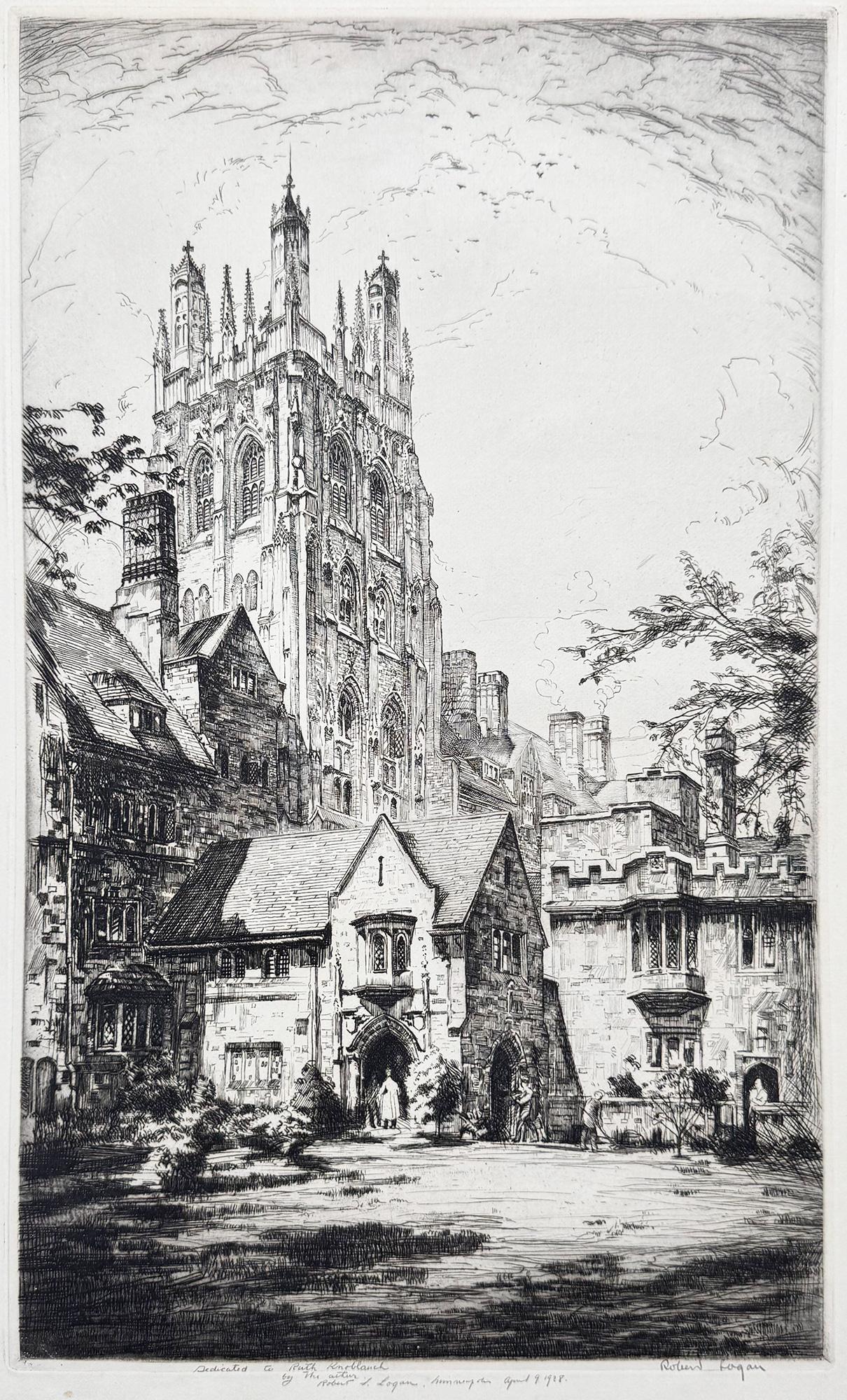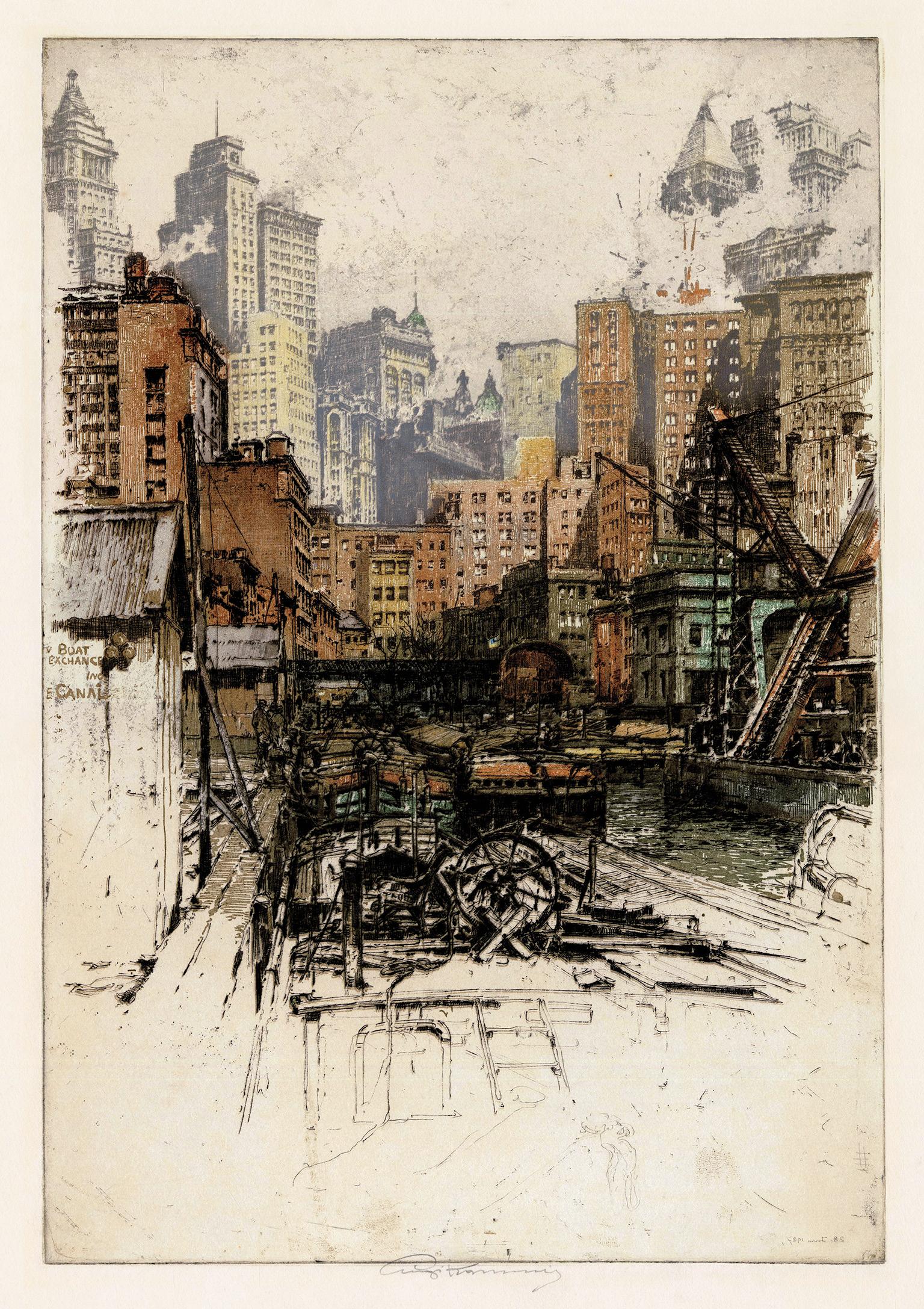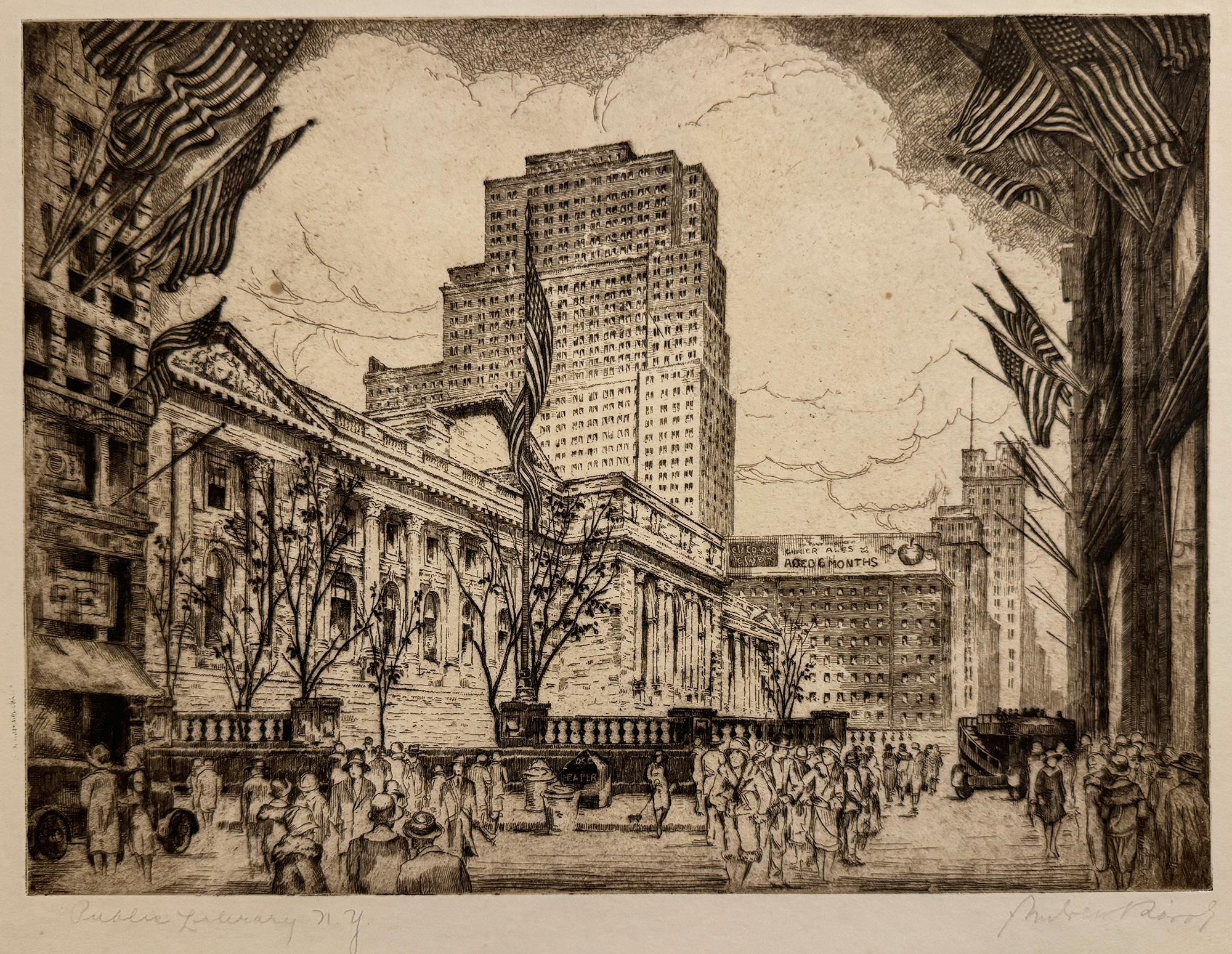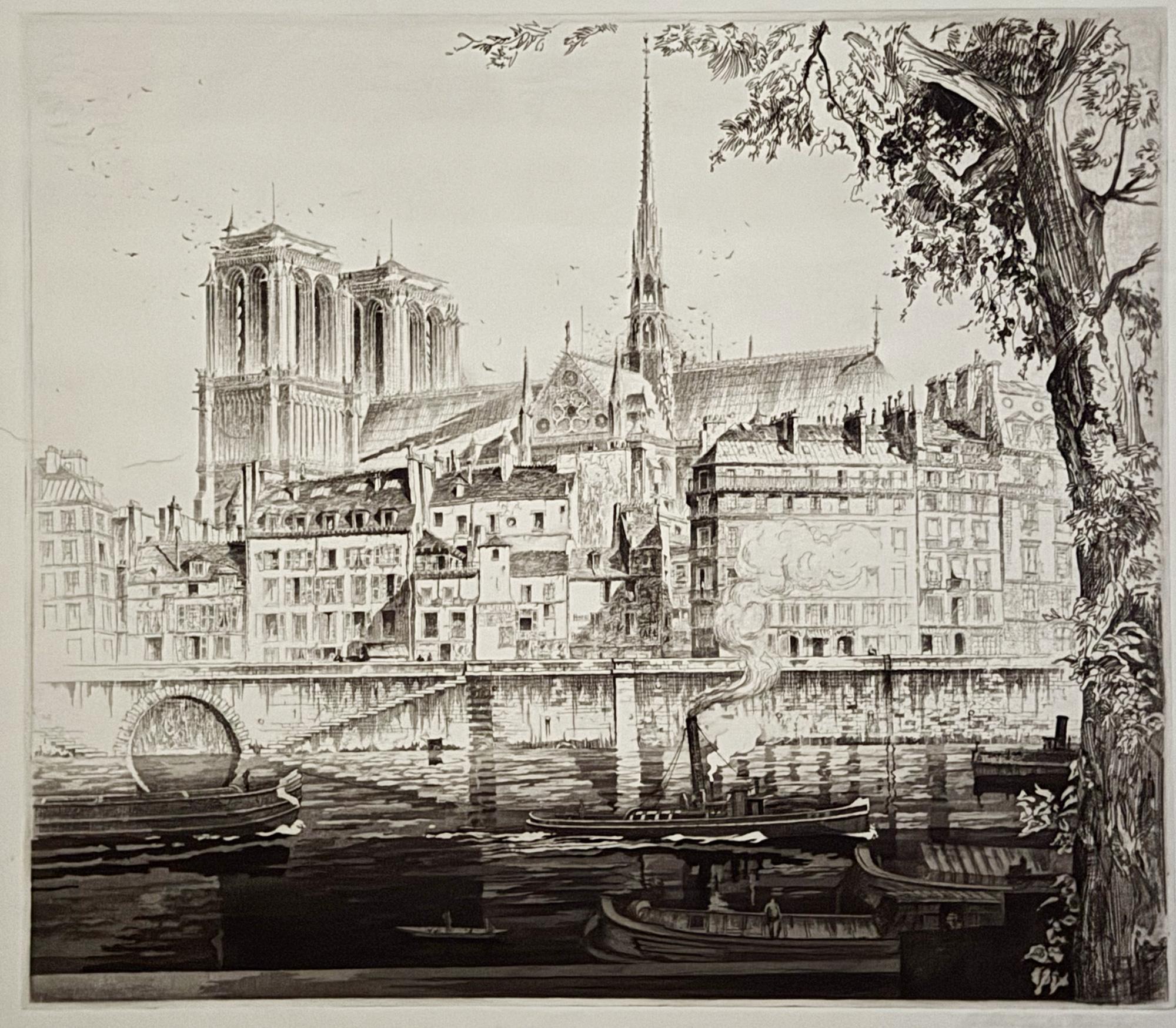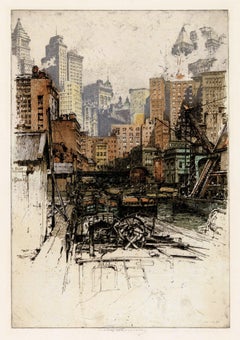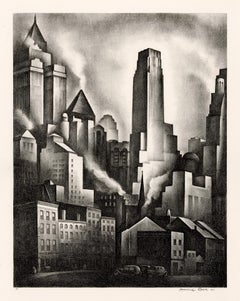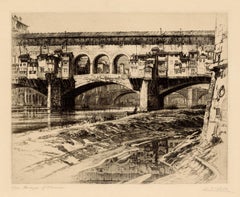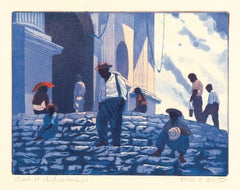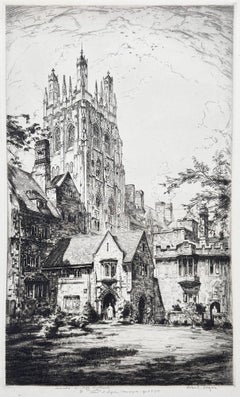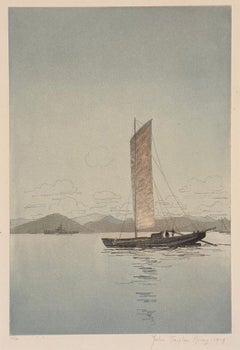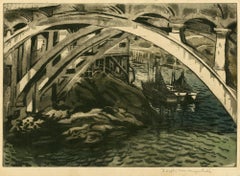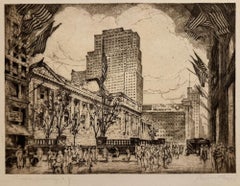Items Similar to 'Brooklyn Bridge' — Iconic New York City Landmark
Want more images or videos?
Request additional images or videos from the seller
1 of 6
Luigi Kasimir'Brooklyn Bridge' — Iconic New York City Landmark1927
1927
About the Item
Luigi Kasimir, 'Brooklyn Bridge', color etching with aquatint, 1927, edition 100. Signed in pencil.
A superb impression, with fresh colors, on heavy, cream wove paper; with margins (2 1/2 to 3 1/8 inches), in very good condition. Matted to museum standards, unframed.
Image size 11 3/8 x 16 13/16 inches (289 x 427 mm); sheet size 17 x 23 inches (432 x 584 mm).
Collection: Zimmerli Art Museum (Rutgers).
- Creator:Luigi Kasimir (1881 - 1962, Austro-Hungarian)
- Creation Year:1927
- Dimensions:Height: 11.38 in (28.91 cm)Width: 16.82 in (42.73 cm)
- Medium:
- Movement & Style:
- Period:
- Condition:
- Gallery Location:Myrtle Beach, SC
- Reference Number:Seller: 1042631stDibs: LU532313287592
Luigi Kasimir
Alois Heinrich “Luigi” Kasimir (Austrian, 1881-1962) was born on April 18, 1881 in Ptuj, Austria (today Slovenia) then a part of the Austro-Hungarian monarchy. He may have inherited his talent from his ancestors; his grandfather was a painter and a poet, and his father, an officer in the Habsburg army, who later became a professional painter. Kasimir attended the Vienna Academy of Art where he studied under Willhelm Unger, who introduced him to the technique of the color etching, and also to his future wife, the artist Tanna Hoernes. Kasimir was among the early practitioners of the multi-plate color etching. Before this, prints were usually hand-colored with the color being applied in a casual, haphazard manner. Kasimir would first create a sketch—usually in pastel. He then transferred the design on as many as four to six plates, printing one after the other and applying the color to the plate - all done by hand. Although Luigi Kasimir is mainly famous for his etchings, but he also produced some oil painting, as well as some pastels. One of his favorite genres was the landscape. He demonstrated a predisposition for monuments, street scenes, and tourist landmarks. He depicted places from all over Europe, mainly Italy, Austria, and Germany. He also travelled to the United States to do a series of etchings of famous sights ranging from urban landmarks such as New York skyscrapers to natural wonders like California’s Yosemite Valley. Kasimir designed a bookplate for Sigmund Freud, who also hung an etching of the Roman Forum by Kasimir in his consulting room. Kasimir’s wife, Tanna and their son Robert worked in a similar style. Luigi Kasimir died in 1962 in Grinzing, a suburb of Vienna, Austria
About the Seller
5.0
Recognized Seller
These prestigious sellers are industry leaders and represent the highest echelon for item quality and design.
Platinum Seller
Premium sellers with a 4.7+ rating and 24-hour response times
Established in 1995
1stDibs seller since 2016
300 sales on 1stDibs
Typical response time: 1 hour
Associations
International Fine Print Dealers Association
- ShippingRetrieving quote...Shipping from: Myrtle Beach, SC
- Return Policy
Authenticity Guarantee
In the unlikely event there’s an issue with an item’s authenticity, contact us within 1 year for a full refund. DetailsMoney-Back Guarantee
If your item is not as described, is damaged in transit, or does not arrive, contact us within 7 days for a full refund. Details24-Hour Cancellation
You have a 24-hour grace period in which to reconsider your purchase, with no questions asked.Vetted Professional Sellers
Our world-class sellers must adhere to strict standards for service and quality, maintaining the integrity of our listings.Price-Match Guarantee
If you find that a seller listed the same item for a lower price elsewhere, we’ll match it.Trusted Global Delivery
Our best-in-class carrier network provides specialized shipping options worldwide, including custom delivery.More From This Seller
View All'Coenties Slip' — Lower Manhattan, Financial District
By Luigi Kasimir
Located in Myrtle Beach, SC
Luigi Kasimir, 'Coenties Slip', color etching with aquatint, 1927, edition 100. Signed in pencil. Dated in the plate, lower right. Annotated 'NEW YORK HANOVER SQUARE (COENTIES SLIP)'...
Category
1920s American Modern Landscape Prints
Materials
Etching, Aquatint
'Financial District', New York City — American Modernism
By Howard Norton Cook
Located in Myrtle Beach, SC
Howard Cook, 'Financial District', lithograph, 1931, edition 75, Duffy 155. A fine, richly-inked impression, on cream wove paper, the full sheet with wide margins (2 3/4 to 5 5/8 inches), in excellent condition. Image size 13 5/16 x 10 3/8 inches (338 x 264 mm); sheet size 23 x 16 inches (584 x 406 mm). Matted to museum standards, unframed.
Literature: 'American Master Prints from the Betty and Douglas Duffy Collection', the Trust for Museum Exhibitions, Washington, D.C., 1987.
Collections: Crystal Bridges Museum of American Art, Library of Congress, Metropolitan Museum of Art, Philadelphia Museum of Art, Smithsonian American Art Museum.
ABOUT THE ARTIST
Howard Norton Cook (1901-1980) was one of the best-known of the second generation of artists who moved to Taos. A native of Massachusetts, he studied at the Art Students League in New York City and at the Woodstock Art Colony. Beginning his association with Taos in 1926, he became a resident of the community in the 1930s. During his career, he received two Guggenheim Fellowships and was elected an Academician in the National Academy of Design. He earned a national reputation as a painter, muralist, and printmaker.
Cook’s work in the print mediums received acclaim early in his career with one-person exhibitions at the Denver Art Museum (1927) and the Museum of New Mexico (1928). He received numerous honors and awards over the years, including selection in best-of-the-year exhibitions sponsored by the American Institute of Graphics Arts, the Brooklyn Museum, the Society of American Etchers, and the Philadelphia Print Club. His first Guggenheim Fellowship took him to Taxco, Mexico in 1932 and 1933; his second in the following year enabled him to travel through the American South and Southwest.
Cook painted murals for the Public Works of Art Project in 1933 and the Treasury Departments Art Program in 1935. The latter project, completed in Pittsburgh, received a Gold Medal from the Architectural League of New York. One of his most acclaimed commissions was a mural in the San Antonio Post Office in 1937.
He and Barbara Latham settled in Talpa, south of Taos, in 1938 and remained there for over three decades. Cook volunteered in World War II as an Artist War Correspondent for the US Navy, where he was deployed in the Pacific. In 1943 he was appointed Leader of a War Art Unit...
Category
1930s American Modern Figurative Prints
Materials
Lithograph
'Bridges of Florence' — Firenze Impressionism
Located in Myrtle Beach, SC
Alonzo C. Webb, 'Bridges of Florence', etching, 1929, edition 100. Signed and titled in pencil. Signed and dated in the plate, lower left. A superb, richly-inked impression, in warm ...
Category
1920s American Impressionist Figurative Prints
Materials
Etching
Church at Chichicastenango
By Jesse F. Reed
Located in Myrtle Beach, SC
Jesse F. Reed, 'Church at Chichicastenango', color etching and aquatint, 1963. Signed and titled in pencil. Signed and dated in the plate, lower right. A fine, richly-inked impression, with fresh colors, on cream wove paper; the full sheet with margins (1 3/8 to 2 1/2 inches), in excellent condition.
Chichicastenango, also known as Santo Tomás Chichicastenango, is a town in the El Quiché department of Guatemala, located in a mountainous region about 140 km northwest of Guatemala City. Chichicastenango is a K'iche' Maya cultural center, with the great majority of the municipality's population indigenous Mayan K'iche. The church depicted is the 400-year-old church Iglesia de Santo Tomás. Built atop a Pre-Columbian temple platform, the steps which remain venerated today, originally led to a temple of the pre-Hispanic Maya civilization. K'iche' Maya priests still use the church for their rituals, burning incense and candles. Each of the 18 stairs that lead up to the church stands for one month of the Maya calendar year.
ABOUT THE ARTIST
Jesse Floyd Reed (1920-2011) studied art in New York City at the Grand Central School of Art and the Art Students’ League. He held degrees in History and English and completed special advance studies in Asian, African, and Latin American art, history and culture. At the time of his retirement, he was a Professor of the Arts Emeritus at Davis & Elkins College, a position he held for over forty-nine years.
A nationally recognized artist since 1947, Professor Reed’s art has been shown in hundreds of museums, libraries, colleges, and universities, including the Boston Museum, National Museum, The Library of Congress, Brooklyn Museum, and Seattle Museum. In his native West Virginia, he is represented in the permanent collections of the Huntington Museum and the Charleston Museum at Sunrise.
The recipient of many national and regional awards, Reed was a member of the Salmagundi Club in NY, the Boston Printmakers, the Print Club of Albany, and was a founding member of the West Virginia Water...
Category
1960s American Modern Landscape Prints
Materials
Etching, Aquatint
'St. Marks on the Bowery' - Famed New York City Landmark
By Leon Dolice
Located in Myrtle Beach, SC
'St. Mark's Church on the Bowery', aquatint with etching, edition not stated but small, 1932. Signed in pencil. Signed in the plate lower left and titled in the plate lower right. A superb, atmospheric impression, on cream wove paper, with full margins (1 1/8 to 2 inches), in excellent condition. Matted to museum standards, unframed.
Image size 9 3/4 x 7 3/8 inches (248 x 187 mm); sheet size 13 1/8 x 10 inches (333 x 254 mm).
Impressions of this work are held in the collections of the Princeton University Art Museum and the Five College Museums.
ABOUT THE ARTIST
Born in Vienna, Leon Dolice left a secure position in the family business to pursue his artistic interests. He began his art education in his teens and early twenties when he traveled through Europe to study the works of the Old Masters. He immigrated to America in 1920 and made his home in Manhattan. As a printmaker, he chose as his subjects the architecture, back streets, dock scenes, and other aspects of New York City life that were being overtaken by the modern world.
In 1950, learning of the coming demolition of the Third Avenue El, Dolice created a series of Third Avenue and other New York City landmarks that were threatened with extinction. His images from that period provide a record of a New York that has passed into history.
During his lifetime, Dolice exhibited throughout Europe and the United States. Retrospectives of his work include a one-man show of his graphic work at Tribeca Gallery, New York; the traveling exhibition ‘Vintage New York’ with the New Rochelle Council on the Arts; and the Hofstra Museum, Hempstead.
Dolice's works are in the permanent collections of the Museum of the City of New York, the National Gallery of Art, the New York Historical Society, Georgetown University, the Philadelphia Print Club, and the New York Public Library, as well as private and corporate collections.
ABOUT ST. MARKS CHURCH
St. Mark's Church in-the-Bowery is a parish of the Episcopal Church located at 131 East 10th Street, at the intersection of Stuyvesant Street and Second Avenue in the East Village neighborhood of Manhattan in New York City. The property has been the site of continuous Christian worship since the mid-17th century, making it New York City's oldest site of continuous religious practice. The structure is the second-oldest church building in Manhattan.
In 1651, Petrus Stuyvesant, Director General of New Netherland, purchased land for a bowery or farm from the Dutch West India Company and, by 1660, built a family chapel at the present-day site of St. Mark's Church. Stuyvesant died in 1672 and was interred in a vault under the chapel.
Stuyvesant's great-grandson, Petrus "Peter" Stuyvesant, sold the chapel property to the Episcopal Church for $1 in 1793, stipulating that a new chapel be erected to serve Bowery Village, the community which had coalesced around the Stuyvesant family chapel. In 1795, the cornerstone of the present-day St. Mark's Church was laid, and the fieldstone Georgian-style church, built by the architect and mason John McComb Jr., was completed and consecrated on May 9, 1799.[4] Alexander Hamilton provided legal aid in incorporating St. Mark's Church as the first Episcopal parish independent of Trinity Church in New York City. By 1807, the church had as many as two hundred worshipers at its summer services, with 70 during the winter.
While the 19th century saw St. Mark's Church grow through its many construction projects, the 20th century was marked by community service and cultural expansion. Today, the rectory houses the Neighborhood Preservation Center, the Greenwich Village Society for Historic Preservation, and the Historic Districts Council, as well as other preservation and community organizations such as the Poetry Project, the Millennium Film Workshop, and the Danspace Project.
St Mark's has supported an active artistic community since the 19th century. In 1919, poet Kahlil Gibran was appointed a member of the St. Mark's Arts Committee, and the next year, the two prominent Indian statues, "Aspiration" and "Inspiration" by sculptor Solon Borglum...
Category
1930s American Modern Landscape Prints
Materials
Etching, Aquatint
'Plowing It Under' — WPA Era American Regionalism
By Thomas Hart Benton
Located in Myrtle Beach, SC
Thomas Hart Benton, 'Goin' Home', lithograph, 1937, edition 250, Fath 14. Signed in pencil. Signed in the stone, lower right. A fine, richly-inked impression, on off-white, wove pape...
Category
1930s American Realist Figurative Prints
Materials
Lithograph
You May Also Like
Wrexham Tower, Yale University
Located in Middletown, NY
Etching with aquatint on watermarked cream laid J Perrigot Arches paper, 15 7/8 x 9 3/4 inches (400 x 248 mm), full margins. Signed, dated, and dedicated to the the artist Ruth Knobl...
Category
Early 20th Century American Modern Landscape Prints
Materials
Handmade Paper, Etching, Aquatint
A Hong Kong Canal Boat
By John Taylor Arms
Located in Middletown, NY
Aquatint with hand coloring in watercolor on watermarked, laid Arches paper, 8 1/16 x 5 9/16 inches (206 x 142 mm), full margins. Signed, titled, dated, and numbered 22/40 in pencil,...
Category
Mid-20th Century American Modern Landscape Prints
Materials
Handmade Paper, Laid Paper, Watercolor, Aquatint
Under the Manhattan Bridge
By Joseph Margulies
Located in Middletown, NY
New York, circa 1940
Etching with aquatint in colors on cream laid paper with a partial watermark and a deckle edge, 11 3/4 x 8 1/4 inches (297 x 208 mm), full margins. Minor mat to...
Category
Early 20th Century American Modern Landscape Prints
Materials
Handmade Paper, Etching, Aquatint
A view of the New York Public Library, looking uptown along 5th Avenue.
Located in Middletown, NY
New York: c 1920.
Etching with aquatint printed in brownish black ink on cream wove paper, 8 3/4 x 12 inches (220 x 304 mm), full margins. Signed and titled in pencil in the lower ma...
Category
1920s American Modern Landscape Prints
Materials
Archival Paper, Etching, Aquatint
Notre Dame de Paris
By John Taylor Arms
Located in Middletown, NY
A superb, dark impression of a well known scene by Arms.
Etching with aquatint on watermarked handmade F.J. Head & Co. laid paper, 12 3/8 x 13 15/16 inches (315 x 354 mm), full marg...
Category
1920s American Modern Landscape Prints
Materials
Handmade Paper, Laid Paper, Etching, Aquatint
The Hospital, Santa Cruz, Toledo
By Samuel Chamberlain
Located in Middletown, NY
Etching with aquatint printed in brownish black ink on watermarked BFK Rives cream wove paper, 9 1/2 x 7 11/16 inches (240 x 193 mm), full margins. Signed in pencil and numbered 79/...
Category
Mid-20th Century American Modern Landscape Prints
Materials
Handmade Paper, Etching, Aquatint
